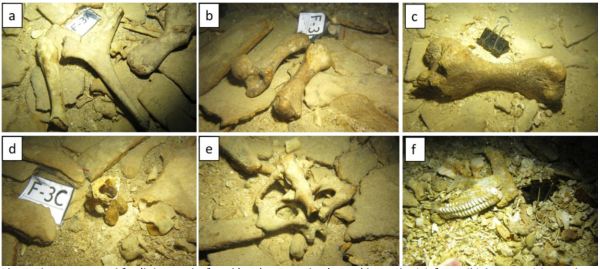Stiva Cave: A New Discover Of Prehistoric Hominid Underwater Cave
DOI:
https://doi.org/10.24273/jgeet.2017.2.2.300Keywords:
underwater cave, hominid, fossil, last glacial maximumAbstract
Stiva Cave is an underwater cave (15,3 m below recent sea level), which located in Nusa Penida, Bali, Indonesia. Nusa Penida is a Karst landscape island in southern Bali Island. No many underwater caves are known and explored in this area, Stiva Cave is a first underwater cave which explored and discovered in Nusa Penida area. In this cave we found a number of fossils that we identified as vertebrate fossil and unique process that very potential for geotourism, especially for fun diving tourism. We mapped entire cave tunnel and measure a safety and risk for scuba diving, then we identified the fossil. At the result, there a several risk that need to be aware and several safety procedures that must be allow for observer. In other way, we found many similar fossils that and it spread in different tunnel that very potential for education in geotourism. We suggest that this cave is a shelter for hominid species when Last Glacial Maximum happens, before 21.000 years ago
Downloads
References
Fairbanks, R. G. 1989. A 17,000-year Glacio-eustatic Sea Level Record: Influence of Glacial Melting Rates on the Younger Dryas Event and Deep-ocean Circulation. Nature , 342, 637-642. doi:10.1038/342637a0.
Geyh, M. A., Kudrass, H., & Streif, H. 1979. Sea Level Changes during the Late Pleistocene and Holocene in the Strait of Malacca. Nature. 278 , 441-443. doi:10.1038/278441a0.
Hanebuth, T., Stattegger, K., & Grootes, P. M. 2000. Rapid Flooding of the Sunda Shelf : A Late-Glacial Sea Level Record. Science , 288, 1033-1035. 10.1126/science.288.5468.1033.
Hesp, P. A., Hung, C. C., Hilton, M., Ming, C. L., & Turner, I. M. 1998. A First Tentative Holocene Sea-Level Curve for Singapore. Journal of Coastal Research , 14 (1), 308-314. doi:10.1029/2005JB003891.
Liu, J. P., & Milliman, J. D. 2004. Reconsidering Melt-water Pulses 1A and 1B: Global Impacts of Rapid Sea-level Rise. Journal of Ocean University of China (Oceanic and Coastal Sea Research),3(2),183-190.doi:10.1007/s11802-004-0033-8.
Sathiamurthy, E., & Voris, H. K. 2006. Maps of Holocene Sea Level Transgression and Submerged Lakes on the Sunda Shelf. The Natural History Journal of Chulalongkorn University , 2, 1-44. DOI: 10.1002/oa.2226.
Solihuddin, T. 2014. A Drowning Sunda Shelf Model during Last Glacial Maximum (LGM) and Holocene: A Review. Indonesian Journal on Geoscience,1(2),99-107. doi: p.10.1038/ 382241a0.
Tjia, H. D. 1992. Holocene Sea-Level Changes in the Malay-Thai Peninsula, a Tectonically Stable Environment. Geol. Soc. malaysia , 31, 157-176. doi: 10.1191/0959683605hl891rp.
Tjia, H. 2014. Stepwise Sea-Level Changes Since Mid-Holocene in Peninsular Malaysia. Sea NGC.
Voris, H. K. 2000. Maps of Pleistocene Sea Level in Southeast Asia: Shoreline, River System and Time Duration. Journal of Biogeography 27 , 1153-1167. doi: 10.1046/j.1365-2699.2000. 00489.x.

Downloads
Published
Issue
Section
License
Copyright @2019. This is an open-access article distributed under the terms of the Creative Commons Attribution-ShareAlike 4.0 International License which permits unrestricted use, distribution, and reproduction in any medium. Copyrights of all materials published in JGEET are freely available without charge to users or / institution. Users are allowed to read, download, copy, distribute, search, or link to full-text articles in this journal without asking by giving appropriate credit, provide a link to the license, and indicate if changes were made. All of the remix, transform, or build upon the material must distribute the contributions under the same license as the original.










